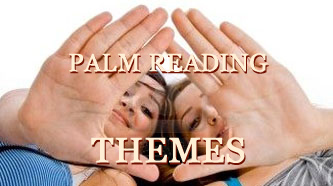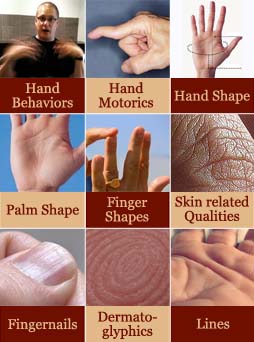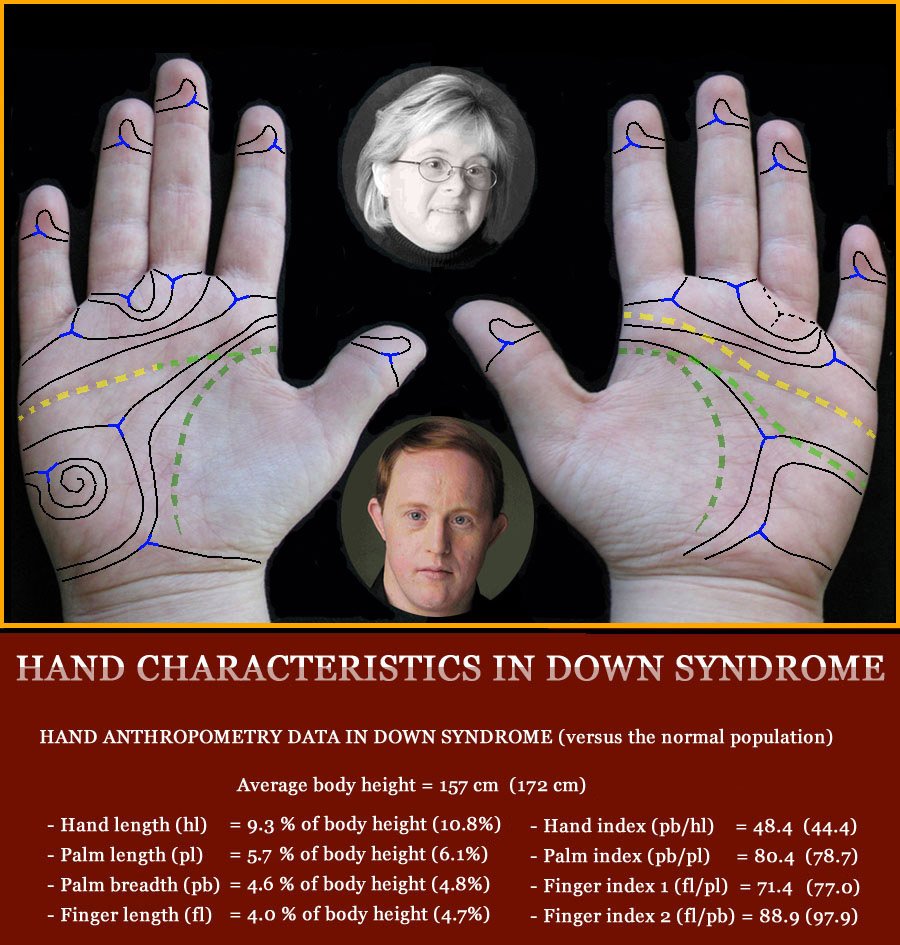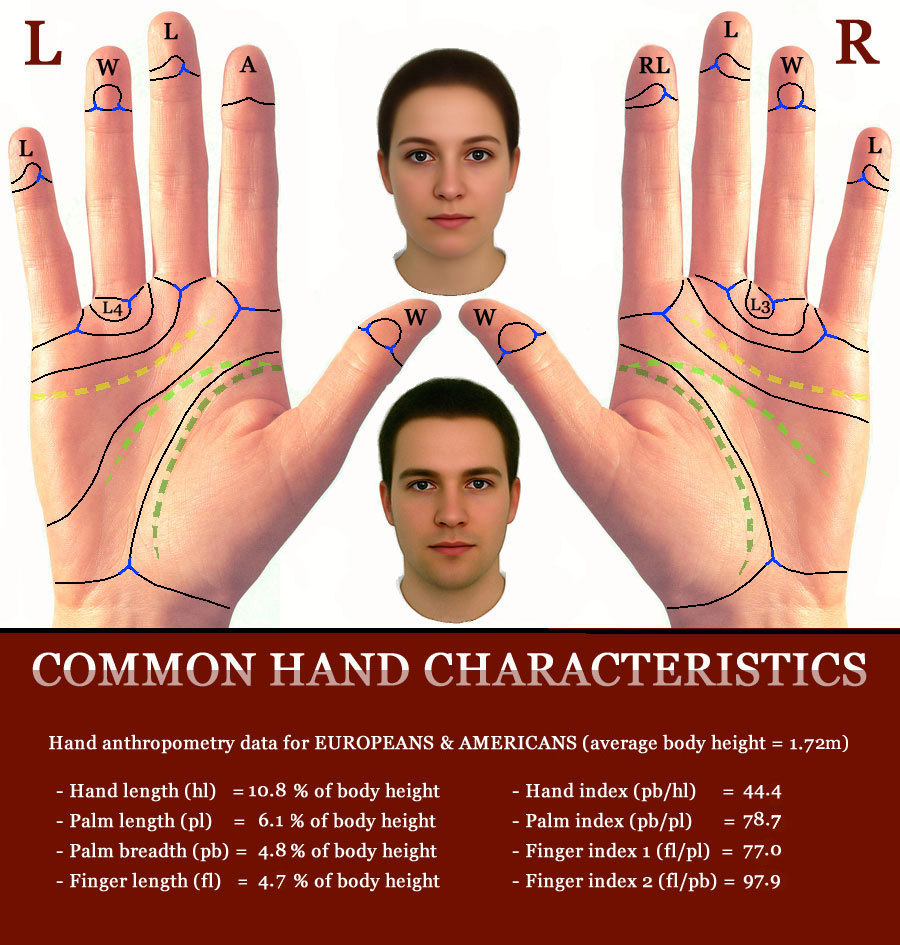|
|

Multi-Perspective Palm Reading themes:
SYNDROMES:
• Down syndrome & the hand system
• Fragile-X syndrome & the hand system
• Marfan syndrome & the hand system
DISEASES:
• Diabetes Mellitus & the hand system
• Psoriasis & the hand system
• Rheumatoid Arthritis & the hand system
PERSONALITY/BEHAVIOR RELATED FEATURES:
• Autism & the hand system
• Extraversion & the hand system
• Schizophrenia & the hand system
Discover more about hands:
• Hand Reading Research
• Hand Reading Forum
• Palm Reading Guide
• Hand Reflexology
Palm reading around the world:
• Chinese palm reading guide: Hong Kong (China)
• Palm reading: children lines & Karachi palmistry (Pakistan)
• Palm Reading: destiny lines & London palmistry (UK)
• Free psychic palm reading in New York (US)
• Indian palm reading: marriage lines & New Delhi palmistry (India)

The hand in Down syndrome is an illustrative 'theme' which provides a deep reflection & understanding regarding how hand structure correlates with hand function.
Even though hands are recognized to represent the most differentiated part of the human body, this intimate connection is usually not highlighted in so-called 'philosophic systems' of hand reading (and hand reflexology).
• Reflexology Charts
|
|
Down syndrome (trisomy 21) & the hand system
according Multi-Perspective Palm Reading!
Rule no.1 - Significant major perspectives in Down syndrome:
Function - Proportion - Skin - Palm - Fingers [= 5 out of 5]
Rule no.2 - Most significant minor level in Down syndrome:
Dermatoglyphics [= level 8]
Down syndrome (trisomy 21) is a genetic disorder caused by the presence of a trisomy on chromosome 21, and it is the most common cause of intellectual disability.
The hand system in Down syndrome varies always clearly in at least 4 out of the 5 major perspectives from the hand in ordinary people; the proportion & skin in both the palm and the fingers are always involved. Usually the 1st major perspective - function - also gets involved with hypotonia (low muscle tone) and/or hyperextensible finger joints (a charteristic that relates to flexible hand motorics which is very commonly present in Down syndrome); however, especially regarding the aspect of hypotonia (which is always present after birth in Down syndrome) there is no clear standard to assess hypotonia in adults. Discover the details with Multi-Perspective Palm Reading!
The most significant minor LEVEL of the hand system in Down syndrome concerns the skin's dermatoglyphics [level 8]. The dermatoglyphics on the fingertips are typically featured with loop fingerprints (ulnar loops in all ten fingers are typical, a radial loop on the ring finger and/or pinky is also typical) + the palm is typically featured with a high positioned axial triradius in the lower section of the palm (hypothenar zone, a.k.a. 'mount of moon' in palmistry), usually combined with transverse alignment of the main lines in the upper section of the palm.
The hand proportions seen in people who have Down's syndrome are also very typical: small relative to their body height, and usually the proportions resemble the so-called (hyper)brachycheir hand shape [level 3]. The extraordinary proportional dimensions of the hand in Down syndrome usually also become manifest in various finger shapes [level 5] Some of the typical hand characteristics in Down's syndrome are summarized in the advanced multi-perspective palm reading hand chart below.
Phantom picture for the hand in Down syndrome (trisomy 21):

Specific aspects of the hand such as the palm & the pinky finger provide a deeper understanding of the hand system in Down syndrome - always involving multiple levels through both aspects:
A fundamental understanding of the hand in Down syndrome can also be acquired by studying the relationship between various aspects of the palm (involving 3 different levels) that are commonly seen in Down syndrome, including:
- the broad/short 'squarish' palm shape [level 4];
- the transverse alignment of the main lines & the distance to the palmar delta below the middle finger is in a large majority of people who have Down syndrome (80% versus about 2% in the general population) smaller than the distance between the deltas below the index finger and the pinky, both concern the dermatoglyphics [level 8];
- and the transversal simian line/Sydney line variations in the lines [level 9].
The pinky finger concerns another aspect of the hand in Down syndrome which nearly always displays (sometimes at multiple levels) multiple of the following seven hand signs (involving 5 different levels of the hand) that can be described as 'uncommon' for the general population:
- hyperextensible finger joints [level 2];
- extraordinary short length [level 5];
- clinodactyly [level 5];
- extraordinary short fingernails [level 7];
- extraordinary small fingernail [level 7];
- radial loop fingerprint [level 8];
- single interphalangeal crease [level 9].
Finally, one of the most common hand sign in Down syndrome that relates to 'hand function' concerns hyperextensisble finger joints [level 2] which represents a very common feature in Down syndrome (present in about 80%, versus about 5% to 10% in the general population).
TIP: Discover more about hands in Down syndrome, including the TOP 5 most significant hand signs in Down syndrome palm reading (selected from 31 significant hand signs):
31 Hand Signs in Down Syndrome
Common hand characteristics in the general population:

|
|